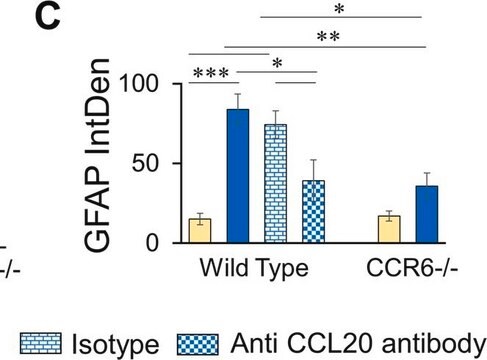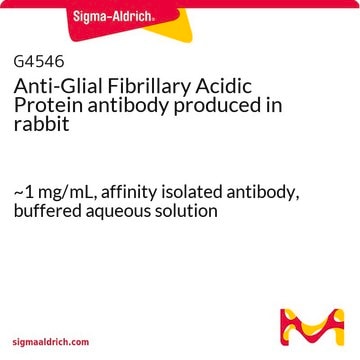G9269
Anti-Glial Fibrillary Acidic Protein antibody produced in rabbit
IgG fraction of antiserum, buffered aqueous solution
Sinonimo/i:
GFAP Antibody Sigma - Anti-Glial Fibrillary Acidic Protein antibody produced in rabbit, Gfap Antibody Sigma, Anti-GFAP
About This Item
Prodotti consigliati
Origine biologica
rabbit
Livello qualitativo
Coniugato
unconjugated
Forma dell’anticorpo
IgG fraction of antiserum
Tipo di anticorpo
primary antibodies
Clone
polyclonal
Forma fisica
buffered aqueous solution
Reattività contro le specie
rat, human
Confezionamento
antibody small pack of 25 μL
tecniche
immunohistochemistry (formalin-fixed, paraffin-embedded sections): 1:80 using brain sections
microarray: suitable
western blot: 1:500 using brain extract
N° accesso UniProt
Condizioni di spedizione
dry ice
Temperatura di conservazione
−20°C
modifica post-traduzionali bersaglio
unmodified
Informazioni sul gene
human ... GFAP(2670)
rat ... Gfap(24387)
Descrizione generale
Specificità
Immunogeno
Applicazioni
- immunohistochemical staining at a working dilution of 1:400 using rat brain sections
- immunohistochemical staining of human brain tumor tissue specimens to identify the cells expressing AQP4 (Aquaporin-4)
- immunofluorescence using brain section from mice
Azioni biochim/fisiol
Stato fisico
Stoccaggio e stabilità
Esclusione di responsabilità
Not finding the right product?
Try our Motore di ricerca dei prodotti.
Anticorpo
Prodotti correlati
Codice della classe di stoccaggio
12 - Non Combustible Liquids
Classe di pericolosità dell'acqua (WGK)
WGK 2
Punto d’infiammabilità (°F)
Not applicable
Punto d’infiammabilità (°C)
Not applicable
Certificati d'analisi (COA)
Cerca il Certificati d'analisi (COA) digitando il numero di lotto/batch corrispondente. I numeri di lotto o di batch sono stampati sull'etichetta dei prodotti dopo la parola ‘Lotto’ o ‘Batch’.
Possiedi già questo prodotto?
I documenti relativi ai prodotti acquistati recentemente sono disponibili nell’Archivio dei documenti.
I clienti hanno visto anche
Il team dei nostri ricercatori vanta grande esperienza in tutte le aree della ricerca quali Life Science, scienza dei materiali, sintesi chimica, cromatografia, discipline analitiche, ecc..
Contatta l'Assistenza Tecnica.













